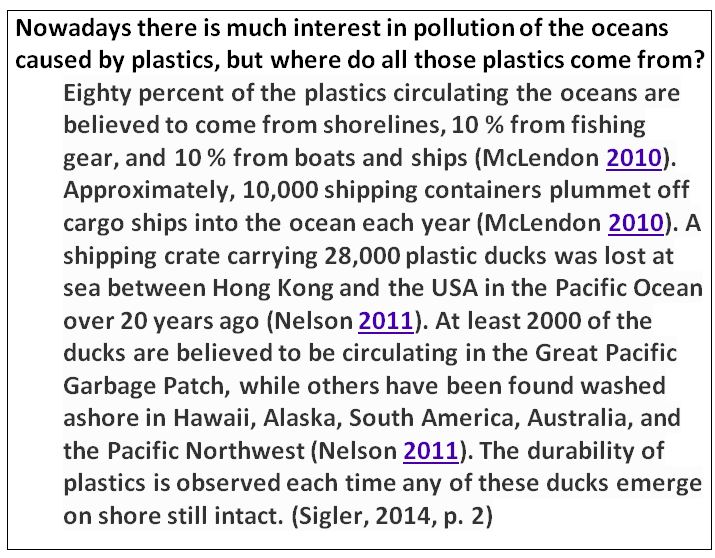How to cite
On this page
Quote, paraphrase or summarize?
When should you use references?
Formatting your references
Reference styles
Reference list vs. Bibliography
Relevant links
References
Scientific writing requires evidence. You cannot just make it up! References to other (scientific and reliable) publications show that you are aware of the background of your topic, of current research, and of relevant official data. They also show that you know how to use all that information to support your findings.
Quote, paraphrase or summarize?
There are three ways in which you can include information from sources in your own text: quoting, paraphrasing, or summarizing.
Quoting
If the exact words of the original document are important, you should quote the text. This is for example the case when it matters which formulation the author used. Put the quotation between double quotation marks to indicate that the words are not your own and add a reference.
Be aware: long quotations with 40 words or more are considered as block quotations and are formatted in an isolated block without quotation marks.
When you quote, bear in mind that:
- Too many quotations make your text difficult to read.
- Quoted texts must not be too long. Your text should mostly be your own, not a copy of someone else’s.
Some examples of direct quotations
- According to Palldino and Wade (2010), “a flexible mind is a healthy mind” (p. 147).
- In 2010, Palladino and Wade noted that “a flexible mind is a healthy mind” (p. 147).
- In fact, “a flexible mind is a healthy mind” (Palladino & Wade, 2010, p. 147).
- “A flexible mind is a healthy mind”, according to Palladino and Wade’s (2010, p. 147) longitudinal study.
- Palladino and Wade’s (2010) results indicate that “a flexible mind is a healthy mind” (p. 147).
Source: McAdoo, T. (2010). How to cite direct quotations
An example of a block quotation
Paraphrasing
In many cases, you want to put the idea(s) from another’s work into your own text and therefore you will paraphrase it. Paraphrasing rather than using direct quotations gives you the opportunity to show that you understand the idea(s) being discussed. A paraphrase is approximately the same length as the original text.
Paraphrase a text by describing the original idea(s) in your own words and adding a reference.
When you paraphrase:
- Use your own words. It is not enough to replace one or two words with a synonym!
- Make sure your readers are absolutely clear about which parts of your text are paraphrases, and which parts are your own ideas.
View this video about paraphrasing
Summarizing
Summarizing means that you describe a significant part of someone else’s work in a few sentences. In this way you are able to include a complete overview of the ideas of someone else’s work into your own.
The rules for summarizing are the same as for paraphrasing: you should use your own words and add a reference.
View this video about how to write a summary
When should you use references?
- When giving an overview of the research carried out previously: your starting point.
- When you use factual (e.g. statistical) data which you did not collect yourself.
- To support a statement: to indicate that it is based on research, not something you just made up.
- Sometimes, but not too often, to illustrate a point you are making.
When information is considered “common knowledge” you don’t need to add a reference. “Common knowledge” is something that anyone familiar with a field of research is expected to know. In case of doubt, it is better to add an unnecessary reference than leave one out which is required.
When you use texts generated by AI tools (such as Chat GPT) it is important to mention this in your work. Describe how you used the tool in your methodology section or introduction and mention the prompt you used when citing a ChatGPT response.
When you publish a text, you want others to credit you when they use your work. The same applies to the authors whose work you use! Using someone else’s work or findings without indicating that you have done so is plagiarism.
- Always quote or paraphrase correctly.
- Better be safe than sorry; it is better to add an unnecessary reference than forget a necessary one.
For more information about TU Delft's policy, see: the TU Delft policy
Formatting your references
There are certain rules for the order of the references in your reference list as well as for the formatting of the references themselves. These rules are determined by the citation style (also referred to as “reference style”) you choose. A reference must contain enough elements to be traceable. There are many different citation styles available.
Usually, you will be told to use a specific citation style, so you can simply look up the style on the internet or in a book and make sure you follow its rules. If you can choose your own style, it is a matter of personal taste. Just make sure you consistently use a single citation style.
Formatting image references
All reproduced images, photographs, tables and figures in your paper must be cited three times: in the text, in the caption beneath the image (including a copyright statement) and in the reference list. A copyright statement is not necessary if you have bought a stock photo or if the image is your own work. In that case use the words “own work” in the caption or add a note in your text stating that photo’s or drawings without reference are your own.
-
In the caption under the image you have to put the following elements:
- Figure X
- Title of the figure
- “From” or “Adapted from” (this is the start of the copyright statement)
- The title, author(s), year of publication, and the source of your image
- Copyright year and the name of the copyright holder
- Copyright permission: “Reprinted [or Adapted] with permission” (only when you have permission) or “In the public domain”.
Example
In-text citation of this example
As shown in fig. 7 Houston is one of the cities in the USA with a light rail system …
In the reference list:
Haase, M. (2006). Light rail Houston [Photograph]. https://commons.wikimedia.org/wiki/File:Light_Rail_Houston.jpg
Reference management software
When formatting references, using reference management software is a real help. Check the TUlib module about Reference management to learn more.
If you don’t want to use reference management software (yet), you can use one of the free online tools to format the references for your paper; for example: BibMe and Scribbr.
If you use these tools don’t forget to check your references!
Reference styles
Reference styles (also referred to as “citation styles’) can be divided into two main groups: author-date styles and numbered styles. Author-date styles are sometimes also called parenthesized styles.
Author-date style | Numbered style | |
|---|---|---|
| In-text reference | (Smith, 2016) or Smith found … (2016). | My article text [¹] or My article text¹ |
| Reference list | References ordered alphabetically, by author’s name. | References ordered numerically, in the order in which they appear in the text. |
| Advantage | A reader can recognize important original texts from the in-text reference, without having to check the reference list. | A reader who wants to check all references while reading a paper, can easily move from one reference to the next without having to search for the next author’s name in a (long) list. |
| Disadvantage | Longer in-text references (for example, references with multiple authors or more than one reference in the same place) can make a text more difficult to read. | In-text references do not contain any useful information themselves. |
| Examples | APA, Chicago, Harvard | Nature, Vancouver, IEEE |
For examples in APA style look at the APA 7th Citation Examples.
Reference list vs. Bibliography
Sometimes these terms are mixed up, but formally a reference list or literature list is a list of all publications (including figures, graphs, tables, datasets etc.) an author refers to (either quotes or paraphrases) in a document to:
- substantiate his/her statements
- describe the context of the subject
- give examples
- show different opinions about the subject
A reference list must be ordered and formatted consistently, according to a single citation style.
A bibliography is more extensive: it also includes works the author read in preparation to writing a document, but did not actually refer to. A bibliography is usually only included in a longer publication, such as a book or a PhD-thesis, while a reference list is customary in all academic writing.
Relevant links
How to cite sources and avoid plagiarism
Take the test on plagiarism!
APA 7th Citation Examples
References
BibMe. (2017). BibMe. http://www.bibme.org/
Cite This For Me. (2017). Harvard Citation Generator. http://www.citethisforme.com/citation-generator/harvard
Frick, T. (2005). What is plagiarism at Indiana University? Indiana University. https://www.indiana.edu/~tedfrick/plagiarism/item1.html
Lee, C. (2016. January 26). Navigation copyright for reproduced images: Part 4. Writing the copyright statement. http://blog.apastyle.org/apastyle/2016/01/navigating-copyright-part-4.html
McAdoo, T. (2010, March 25). How to cite direct quotations. http://blog.apastyle.org/apastyle/2010/03/how-to-cite-direct-quotations.html
McAdoo, T. (2023, April 7). How to cite ChatGPT. https://apastyle.apa.org/blog/how-to-cite-chatgpt
Sigler, M. (2014). The effects of plastic pollution on aquatic wildlife: current situations and future solutions. Water, Air, & Soil Pollution 225(2184). https://doi.org/10.1007/s11270-014-2184-6
TU Delft. (2017). Fraud & Plagiarism. https://www.tudelft.nl/en/student/legal-position/fraud-plagiarism/

